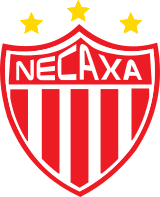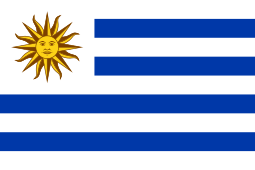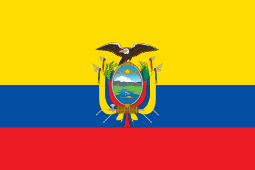Club Necaxa
Impulsora del Deportivo Necaxa S.A. de C.V. (pronounced [ne.ˈkak.sa]); often simply known as Club Necaxa, is a Mexican football club in Liga MX based in the city of Aguascalientes. It plays in the Estadio Victoria.
 | |||
| Full name | Impulsora del Deportivo Necaxa S.A. de C.V. | ||
|---|---|---|---|
| Nickname(s) | Los Rayos (The Lightning) Los Electricistas (The Electricians) Los Once Hermanos (The Eleven Brothers) El Equipo de la Década (The Team of the Decade) | ||
| Founded | 21 August 1923 | ||
| Ground | Estadio Victoria Aguascalientes City, Aguascalientes, Mexico | ||
| Capacity | 23,851 | ||
| Owner | Ernesto Tinajero Flores | ||
| Chairman | Ernesto Tinajero Flores | ||
| Manager | Alfonso Sosa | ||
| League | Liga MX | ||
| Apertura 2019 | 5th (semi-finalist) | ||
| Website | Club website | ||
|
| |||
History
Foundation (Light and Power Company, Luz y Fuerza) (1899–1920)
Necaxa was founded on 21 August 1923. It began when Englishman William H. Frasser, an engineer and owner of the Light and Power Company (Compañía de Luz y Fuerza) in the state of Puebla, founded a football team. Frasser, as a student was a football player in the United Kingdom and was a strong advocate for the sport. Frasser consolidated the teams of the Light and Power Company and the Street Car operators Compañia de Luz y Fuerza and Tranvías into one.
Frasser supported the newly merged team with company revenue and funds. In addition, the Light and Power Company offered steady employment to players in an era where half of the players were playing at an amateur level.[1] However, the Mexican football federation did not allow teams to be named after private companies, so the team changed its name to Necaxa, after the Necaxa River that was close to the electrical plant.
Historians assert that the colors and Necaxa's crest came from following the arrival of the Cornish community in Mexico,[2] the Cornish community flourished and stayed in Central Mexico until the Mexican Revolution in 1910. Although the Cornish community in Mexico broadly returned to Cornwall, they left a cultural legacy; Cornish pasties, Cornish mining museums, a Cornish Mexican Cultural Society and football, are part of the local heritage and tradition in and around Mineral del Monte.[3] In 1923, it was decided Necaxa team would field players regardless of race and nationality.
In that era, the team was called "Los Electricistas" (The Electricians). The team adopted the colors red and white as their team colors, earning them the nickname "Los roji-blancos". During this period, the oldest rivalry in Mexican football began to form, between Necaxa and Atlante F.C..
On 14 September 1930, having already been a 2-time champion of the amateur Copa Eliminatoria, Necaxa inaugurated its stadium named Parque Necaxa, located on the banks of La Piedad River on land donated by the Frasser Family. The stadium had a maximum capacity for 15,000 fans, and was known for its clock tower displaying the team's emblem.
Necaxa, in the early days of Mexican Football were members of the Mexican League Amateur Football Association Liga Mexicana de Fútbol Amateur Association, composed of Atlante F.C., Club España, Germania FV, and seasoned and disciplined team Asturias. Necaxa won championships during the 1932–33, 1934–35, 1936–37, 1937–38. seasons.[4]
The following season after the stadium's opening, players such as Hilario López and Luis Pérez contributed to the team's success, leading Necaxa to the League final against Atlante, losing 3–2.
But Necaxa would rebound the next season, smashing Atlante by a 9–0 score. The line-up Necaxa used on that day was the following:
|
Mexico
|
Foreign
|
During this decade, Necaxa became one of the most popular teams in Mexico. Under the direction of the Ernst Pauler, Necaxa, in one season of play (1935–36), the team dominated and won titles ranging from Champion of Champions, Champion of the Liga Mayor De La Ciudad, National Champion of League, National Champion and Central American Champions. Their last title was the Central American Championship in El Salvador.
1935 Caribbean games lineup
|
Mexico |
|
"Paco" Martinez de la Vega, an aficionado, would coin the surname for the very first time" Campeonismo" or "Championshipism" in which Necaxa's would later use to justify their achievements and titles.[1]
Late 1930s: Once Hermanos
Following the Mexican Revolution, the late 1930s represented Necaxa's most successful all-Mexican team. The Once Hermanos or "Eleven Brothers" period was coined in that era due to that team's ability to work as a team. The Necaxa team, in 1936, won the Copa México.
In that same year, a talented striker gained popularity within Necaxa's benches. Even though he was not one of the original "once hermano" or "eleventh brother" Horacio Casarìn, was a great player in the Mexican league national ranks. His success took him to the big screen in Mexican Cinema.[1]
Necaxa's "Once Hermanos" lineup
|
Mexico
|
Mexico |
1940s brief hiatus
Necaxa disappears from competitive play within the Mexican League in 1943[6] altogether due to the professionalization of Mexican Football. It would be half a decade before the Necaxa emblem and uniform would be represented on the field again.[1]
1950-60s resurgence
Seven years later, Club Necaxa returns to play under the conditions of the commercialization of the Mexican league. Under the new ownership of the Union of Electricians and Juan Jose Rivas Rojas, Club Necaxa played their first game on 25 September 1950 in the old district of Oblatos, in a stadium called Parque Oblatos or "Oblatos Stadium" otherwise called the Municipal Stadium of Felipe Martinez Sandoval in Guadalajara, Mexico. This park inaugurated Necaxa's comeback to football. In the fifties, Necaxa were tenants and played in the Federal District of Mexico City in present-day Estadio Azul (1950–55).
In the late sixties, Necaxa played football in Estadio Azteca in Mexico City. A modern lighting system in Estadio Azetca was inaugurated on 5 June 1966 with the first night game between Valencia CF and Necaxa. The first goal of the game was scored by Honduran José Cardona. In this game Roberto Martínez o Caña Brava scored the first goal made by a Mexican. Estadio Azteca was the largest stadium in Latin America, and the fifth largest stadium in the world. It is known throughout North America and South America as the home stadium for the Mexico national football team.
Throughout the 1950s Necaxa struggled financially to keep afloat. In 1955, large debts obliged Necaxa to sell the majority of its star players. Miguel Ramierz Vazquez a new owner, contracted the services of the Uruguayan coach Donald Ross, who eventually took Guadalajara to a championship 1957, beginning a road to stability, yet not winning championships.
The electricians won the Title cup in 1960 and the following year, in the Universidad Nacional Autonoma de Mexico Olympic stadium, "the electricians" defeated Rey Pele and the club and team of the Santos of Brazil 4–3 in an official match of that year's "Exagonal" tournament. "Morocho" Dante Juarez assisted in two victorious goals in Necaxa's win over the Santos de Brazil.
Through the early 1960s, Necaxa struggled financially until it was sold. New owners,Julio Orvañanos brought a championship in 1965–66.[1]
Mexico 68 and Carlos Albert vs Necaxa
In this decade, the organization was in financial trouble. The team had poor attendance in Mexico City due the population unrest.
The case of Carlos Albert begins with a small group of veteran footballers in the spring of 1969. Club Necaxa Veteran players petitioned the organization for better wages and argued that as a team and group, they have always responded to the team's performance. Carlos Albert was the face of the disagreement between the players and management.
Albert was listed by Necaxa Management as transferable and was retained on half his salary. He asked management to void his contract in order, to avoid loss of income and to be able to continue playing in the League with another team. Necaxa Management did not accept his request.
The courts ruled in favour of Albert on Thursday 8 October 1971, and Necaxa was forced to pay MX$77,000 to Carlos Albert. Due to the will of managements unfair psychological abuse and labour malpractice, This case forced a cause to action from several players to request better treatment and more rights for Necaxa football players.
Atlético Español 1971 to 1982
On 19 September 1971, Club Necaxa experienced financial trouble and became in debt with players and management. The owners sold the club to a group of businessmen from Spain. The ownership handled the player contracts, disputes and the franchises debt. The new Spanish ownership restructured contracts and made Club Necaxa solvent. The club plays under the name of the Spanish Athletic Bulls or "Toros del Atlético Español".
In 1975, the organization won their only international title in the CONCACAF Champions' Cup, playing the final against Transvaal of Suriname and defeating them 5–1 on aggregate. In 1973–74, they reached the final against Cruz Azul. They played a two-legged tie in which the Atlético Español won the first leg 2–1 but lost the second 3–0, becoming sub champion of the league.
Players who distinguished themselves in Atlético Español were the Brazilian striker Carlos Eloir Perucci, Ricardo Brandón, Salvador Plascencia,'Sabanita' Rivera, Juan Santillán, and Tomás Boy, under the direction of Miguel Marín, 'the Witch' Gutiérrez, Enrique Díaz and 'Chucho' Prado and the Chiliean Prieto.[7]
In 1982, the Spanish ownership within the Federal District of Mexico city sold the franchise. A new group of Mexican businessmen purchased Necaxa in 1982, then telecommunications Giant Grupo Televisa returned the organization's original name from 1971 and opened its training facilities in Cuautitlán Izcalli in the state of Mexico.[8] The ownership renamed the franchise Necaxa by 1982 after the cultural and historical importance of the franchise in Mexican football. While Mexico experienced a crisis called "the Lost Decade" or "La Decada Perdida"[9] in the 1980s and early 1970s, Necaxa in the 1980s struggled against two relegation matches. One at the end of the 1982–83 season against Zacatepec and another by the end of the 1984–85 season against Leones Universidad de Guadalajara.
Atlético Español footballers: Goalkeepers: Julito Aguilar, Jan Gomola, Goyo Cortez, Enrique Vazquez del Mercado, Defense: El Pimienta Rico, Juan Manuel Alvarez, Mario Trejo, Midfielder: Juan Carlos Rodriguez Vega, Manuel Manzo, Benito Buen Hombre Pardo, Tomas Boy. Forwards: Juan Manuel Borbolla, J.J. Muñante, Romano, Carlos Eloir Perucci, El Cachito Ramirez, Ricardo Brandon, Pio Tabaré Gonzalez, Juan Carlos Rossete
New Owners and return to glory (1990–2000)
In 1988, Futbol Club Necaxa was purchased by Mexican telecommunications giant Grupo Televisa S.A C.V. The now late owner, Emilio Azcárraga Milmo (father of Emilio Azcárraga Jean), and several associates took a new direction with the team.
In the 1989 and 1990 season, director of football operations Anibal Ruiz acquired the services of the Ecuadorian midfielder, Álex Aguinaga, one of the iconic figures of the Necaxa in the 1990s and one of the most talented foreign players who has ever set foot on Mexican soil.
Necaxa has a great season, previously in the 1980s they battled twice against México Primera División's regulations of the Mexican League. In that year Necaxa reached the finals losing to Pumas of the University of Mexico. The following season Aníbal Ruiz was replaced with new coach, the Argentine ex-defender, Eduardo Luján Manera who contracted the services of the Chilean Ivo Basay. Under Manera, Necaxa didn't qualify for the finals of the championship. The acquisition of new coach Roberto Saporiti, marked the beginning of a commitment to competition excellence in a period known to Necaxa fans as "La Epoca Necaxista bajo el Capitalismo" or "the new era of Necaxa under Capitalism".
In 1992, the talented footballer of UNAM, ex-Puma player Enrique Borja was put under contract and headed the club's football operations, leaving Saporiti as head coach of Necaxa. Eventually Saporitti was replaced. The team Saporitti, Manera, Ruiz leave was an offensive minded team, that was disciplined, yet lacked great defensive talent. The following season management engaged the services of Manuel Lapuente. Sergio "El Ratón" Zarate, Octavio "Picas" Becerril, the Chilean Eduardo "Lalo" Vilches, José María "El Chema" Higareda were key figures in the defense and offense of the club. Manuel Lapuente managed Club Necaxa to three Championship titles in Mexico's National Football League.
After 56 years, once again Necaxa found itself with the title of "Campeonísimo", contributing talent in the 1990s and late in the millennium, within the Primera División of the Mexican League and in the Mexico national team.
They won the Mexican League Championship in 1994 (beating Cruz Azul), in 1995 (beating Celaya) and 1998 (beating Guadalajara), becoming Champion of CONCACAF and champion of champions the legacy of the "Once Hermanos" attempted to be reestablished within the franchise's values and mind set. The Necaxa team of the 1990s and represented the cohesion and ability of working and playing as a team under lucrative financial incentives, forced great communication on the field and execution on the field during advanced Capitalism competition play. Necaxa's Championships were similar, yet different reminder of the spirit of "Los Once Hermanos" or "the Eleven Brothers" in the late 1930s.
Relocation and new home (2000–2009)
After poor attendance numbers during the early 2000s, Necaxa needed to refresh their home and relocate to improve on this issue. Many considered Estadio Victoria in Aguascalientes to be the first modern stadium built in Mexico.
Attendance continued to decline steadily despite the change of city and stadium for Necaxa. This consistent decline would lead to a relegation for Necaxa during the Spring 2009 campaign.
The Hidrorayos would bounce back winning the fall 2009 and Spring 2010 (undefeated) Ascenso MX titles thus earning an automatic promotion back up to the Liga MX.
Necaxa in Primera División and return to Ascenso MX (2011–present)
After winning the 2009–10 promotion, Necaxa returned to the FMF Primera División for the 2010–11 campaign. Omar Arellano began the season with Daniel Brailovsky taking over for the remainder of the tenure. Ultimately the club faced immediate relegation after only one year.
Despite having a good performance in the 2nd division, Necaxa was initially unable to return to the top flight, losing two finals in 2013 against Neza FC and Universidad de Guadalajara.
On December 6, 2014, Necaxa won the Apertura 2014 championship in the final game against Coras de Tepic ultimately losing the promotion play-off against Dorados de Sinaloa.
The Apertura 2015 tournament was not good for Necaxa, finishing in 10th place. However, in Clausura 2016, Necaxa finished the regular season as runner-up, one point behind U. de G. In the playoffs, Necaxa beat Correcaminos 2–1 in the Quarterfinals, Atlante 5–3 in the Semifinals, and Zacatecas 2–0 in the Finals to become champion. Next was a two-legged playoff series against Cd. Juarez, the Apertura 2015 champion. Necaxa won the first leg in Aguascalientes 1–0, and one week later in Cd. Juarez 2–0, thus clinching its return to Primera Division Liga MX for the first time in five years.
Sponsorship
| Period | Kit manufacturer | Shirt partner |
|---|---|---|
| 1922–23 | No sponsors* | Mexican Light & Power Company, Ltd. |
| 1922–23 | No sponsors* | StreetCar Operators |
| 1923–26 | No sponsors* | |
| 1926–36 | No sponsors* | |
| 1936–40 | No sponsors* | |
| 1950–70 | To be determined* | |
| 1971–82 | To be determined | |
| 1987–88 | Adidas | Choco Milk |
| 1989–92 | Adidas | |
| 1993–94 | Adidas | Coca-Cola / Elf |
| 1994–95 | Adidas* | Coca-Cola / Elf |
| 1995–96 | Umbro* | Coca-Cola / Elf |
| 1996–97 | Umbro | Coca-Cola / AFORE Garante |
| 1998 (Winter'98) | Umbro* | Coca-Cola |
| 1999-00 | EEscord | Coca-Cola |
| 2000–01 | EEscord | Coca-Cola/Sol |
| 2001 | EEscord | Masfresco / Victoria / Coca-Cola |
| 2002 | Atletica | Coca-Cola / Victoria |
| 2003 | Atletica | Bimbo / Victoria / Coca-Cola |
| 2004 | Atletica | Bimbo / Office Depot / Victoria |
| 2005 | Atletica | Visa / Leche San Marcos / Banamex / Corona |
| 2006 | Atletica | Visa / Seguros Argos SA de CV / Leche San Marcos / Corona / Banamex |
| 2007–08 | Atletica | Visa / Seguros Argos SA de CV / Leche San Marcos / Corona / Aeroméxico / Banamex / Cemex Monterey / Caja Libertad |
| 2008 | Voit | Sabritas / Corona / Leche San Marcos |
| 2009 | Voit | Diversity Capital / Corona / Leche San Marcos |
| 2009–10 | Voit* | Caja Popular Mexicana / Corona / Seguros Argos |
| 2010–11 | Atletica | Caja Popular Mexicana / Corona / ETN / Pepsi / Rolcar / ETN / Bimbo[10] |
| 2011–12 | Atletica | Futura/Leche San Marcos/Corona/Caja Popular Mexicana/SKY/Coca-Cola/Trucka/Rolcar/Agro depot[10] |
| 2012–13 | Pirma | ETN/Leche San Marcos/Meson del Taco/Corona/Caja Popular Mexicana/SKY/Coca-Cola/Trucka/Rolcar/Agro depot[10] |
| 2013–14 | Pirma | Aeroméxico/Coca-Cola/Corona/ETN/Leche San Marcos/Pizza Ola/Rolcar/SKY/Trucka/Oxxo Gas[10] |
| 2014-17 | Umbro | Aeroméxico/Coca-Cola/Corona/ETN/Búfalo/Leche San Marcos/Pizza Ola/Rolcar/SKY/Trucka/Oxxo Gas[10] |
| 2017–present | Charly | Rolcar/Cavall Sport/Búfalo/Circle K/Coca-Cola/Mercedes-Benz/SKY/Mediotiempo |
- Championship jerseys
First kit evolution
|
1922–1923[11]
|
Second 1922–23
|
1922–23
|
1923–71
|
1971–81
|
1973–75
|
1972
|
1990–present kit evolution
|
1992
|
1994
|
1995
|
1996
|
1999
|
2005
|
2011
|
Honours
Domestic
| Type | Competition | Titles | Winning Seasons | Runners Up |
|---|---|---|---|---|
| Primera Division de Mexico | 3 | 1994–95, 1995–96, Invierno 1998 | Invierno 1996, Verano 1998, Verano 2002 | |
| Copa MX | 8 | 1924–25, 1925–26, 1932–33, 1935–36, 1959–60, 1965–66, 1994–95, Clausura 2018 | 1933–34, 1939–40, 1941–42, Clausura 2016 | |
| Campeón de Campeones | 2 | 1966, 1995 | 1960 | |
| Supercopa MX | 1 | 2018 | 2019 | |
| Ascenso MX | 4 | Apertura 2009, Clausura 2010, Apertura 2014, Clausura 2016 | ||
| Campeón de Ascenso | 2 | 2009–10, 2015–16 | 2014–15 | |
| Campeonato de Primera Fuerza de la FMF/Liga Mayor | 4 | 1932–33, 1934–35, 1936–37, 1937–38 | 1924–25, 1931–32, 1939–40 | |
Confederation
| Type | Competition | Titles | Winning Seasons | Runners Up |
|---|---|---|---|---|
| 2 | 1975 (as Atlético Español), 1999 | 1996 | ||
| CONCACAF Cup Winners Cup | 1 | 1994 | ||
Personnel
Coaching staff
| Position | Staff |
|---|---|
| Manager | |
| Assistant managers | |
| Goalkeeper coach | |
| Fitness coach | |
| Physiotherapist | |
| Team doctors | |
Players
First-team squad
- As of 12 January 2020[12]
Note: Flags indicate national team as defined under FIFA eligibility rules. Players may hold more than one non-FIFA nationality.
|
|
Out on loan
|
|
Reserve teams
Historical Championship Squads
|
1994–95 Champions
|
1995–96 Champions
|
Winter 98
|
Top scorers
.jpg)
Historical Amateur leading scorers
- 1926–27

- 1931–32

- 1932–33

- 1934–35

- 1936–37

Historical Leading Season scorers
- 1950–51

- 1952–53

- 1953–54

- 1954–55

- 1983–84

- 1992–93

- Verano 2000

- Apertura 2012

- Clausura 2013

All-time leading scorers
| Player | Goals | Nationality |
|---|---|---|
| Ricardo Peláez | 138 | |
| Ivo Basay | 101 | |
| Víctor Lojero | 86 | |
| Álex Aguinaga | 82 | |
| Alberto García Aspe | 65 | |
| Julio Maria Palleiro | 64 |
Managers
This is the list of managers who had the Club Necaxa in short tournaments:
| Name | Tournament | Led Games | Games Won | Tied Games | Games Lost |
|---|---|---|---|---|---|
| Enrique Díaz | 1982 | 16 | 2 | 7 | 7 |
| Walter Ormeño | 1982–84 | 60 | 14 | 27 | 19 |
| José Antonio Roca | 1984–85 | 38 | 5 | 15 | 18 |
| Mario Pérez | 1986–87 | 40 | 7 | 24 | 9 |
| Cayetano Ré | 1987–88 | 46 | 15 | 15 | 16 |
| Aníbal Ruiz | 1988–90 | 70 | 24 | 28 | 18 |
| Eduardo Luján Manera | 1990–91 | 38 | 12 | 11 | 15 |
| Roberto Saporiti | 1991–94 | 121 | 52 | 39 | 30 |
| Manuel Lapuente | 1994–95 – Inverno 97 | 61 | 26 | 15 | 20 |
| Raul Arias | Verano 98 – Clausura 2005 | 297 | 120 | 76 | 101 |
| Enrique López Zarza | Apertura 2005 – Apertura 2006 | 45 | 16 | 10 | 19 |
| Pablo Luna | Apertura 2006 | 1 | 0 | 1 | 0 |
| Hugo Sanchez | Apertura 2006 | 7 | 2 | 1 | 4 |
| Jose Luis Trejo | Clausura 2007 | 17 | 4 | 6 | 7 |
| Hans Westerhoff | Apertura 2007 | 17 | 5 | 5 | 7 |
| Salvador Reyes | Clausura 2008 – Apertura 2008 | 33 | 6 | 18 | 9 |
| Octavio Becerril | Apertura 2008 | 5 | 2 | 2 | 1 |
| Raul Arias | Clausura 2009 | 17 | 3 | 5 | 9 |
| Omar Arellano Nuño | Apertura 2009 – Bicentenario 2010 | 44 | 22 | 17 | 5 |
| Daniel Brailovsky | Apertura 2010 – Clausura 2011 | 15 | 3 | 1 | 11 |
| Sergio Bueno | Clausura 2011 | 13 | 3 | 6 | 4 |
| Paco Ramírez | Apertura 2011 | 12 | 5 | 4 | 3 |
| Luis Francisco García Llamas | Apertura 2011 | 3 | 1 | 1 | 1 |
| Tita | Clausura 2012 | 12 | 8 | 3 | 3 |
| Jaime Ordiales | Apertura 2012 – Apertura 2013 | 28 | 14 | 10 | 4 |
| Armando González | Apertura 2013 – Clausura 2014 | 38 | 18 | 12 | 8 |
| Miguel de Jesús Fuentes | Apertura 2014 – 2015 | 36 | 15 | 9 | 12 |
| Alfonso Sosa | 2015–2017 | 38 | 19 | 13 | 6 |
| Ignacio Ambríz | 2017–2018 | 47 | 18 | 18 | 11 |
Fan clubs
- Sobredosis Albirroja "The Red and White Overdose"
- Comando Rojiblanco
- La Popular
- Pasión Albirroja
References
- La serie Mexico Nuevo Siglo: Rueda de la Fortuna Los Rayos
- Logan James (reprint 1976). The Scottish Gael Or Celtic Manners. John Donald Publishers Ltd. pp. 249–250. ISBN 0-85976-021-9.
- "The Cornish in Mexico", bbc.co.uk, 30 September 2008, retrieved 2009-09-07
- "Mexico - List of Final Tables". www.rsssf.com.
- "Señor Gol – en sida om Mexikansk fotboll". Señor Gol. Archived from the original on 7 November 2003. Retrieved 25 June 2015.
- "Carlos Calderón: El Necaxa III. Los gloriosos años 30 - mediotiempo.com". 14 June 2009. Retrieved 25 June 2015.
- "La Vieja Guardia – Pasión Rojiblanca". Retrieved 25 June 2015.
- "Necaxa deja Cuautitlán". Archived from the original on 26 June 2015. Retrieved 25 June 2015.
- "La Década Perdida". Retrieved 25 June 2015.
- "Archived copy". Archived from the original on 25 February 2010. Retrieved 6 March 2010.CS1 maint: archived copy as title (link)
- Liga Mx / Ascenso Mx. "Página Oficial de la Liga del Fútbol Profesional en México .: Bienvenido". Liga Mx. Retrieved 18 October 2018.
